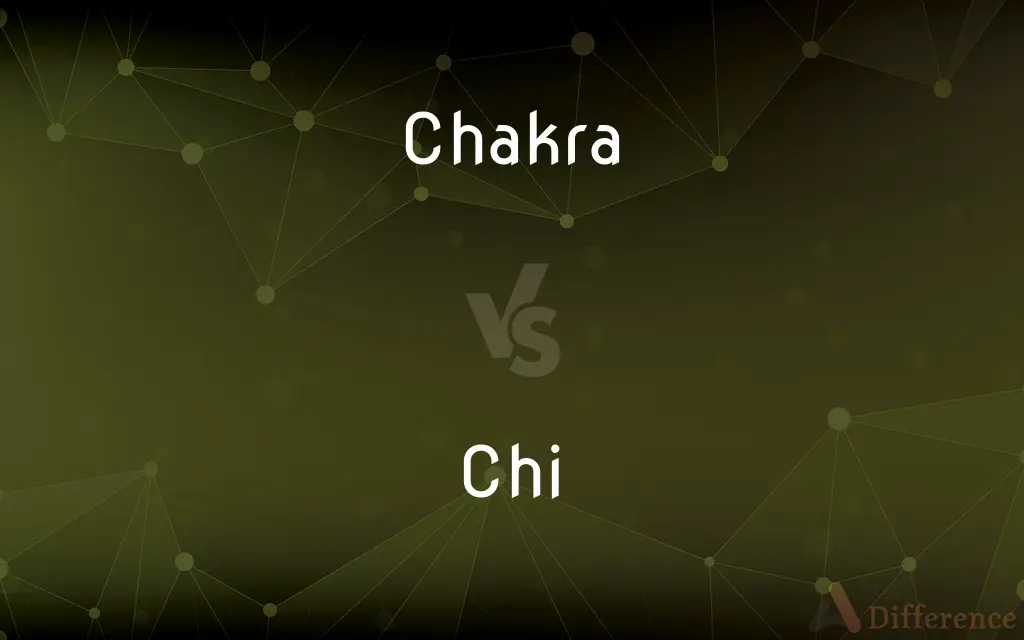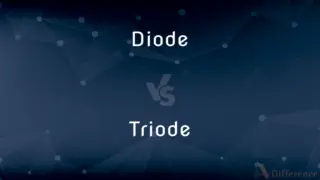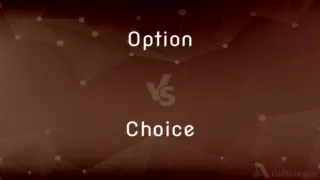Chakra vs. Chi — What's the Difference?
Edited by Tayyaba Rehman — By Urooj Arif — Updated on April 3, 2024
Chakra refers to energy centers within the body in Hindu and Buddhist traditions, focusing on spiritual energy flow. Chi (Qi) is a foundational concept in Chinese medicine and martial arts, representing life force energy.

Difference Between Chakra and Chi
Table of Contents
ADVERTISEMENT
Key Differences
Chakra, a term rooted in Hindu and Buddhist traditions, describes specific energy centers along the body that are thought to govern various physical, emotional, and spiritual aspects of our being. Whereas chi, also known as qi, is a concept from Chinese philosophy and medicine, representing the vital life force that circulates through all living things, emphasizing the flow of energy throughout the body.
The chakra system includes seven main chakras, each located at a different point on the body's central axis, from the base of the spine to the crown of the head. Each chakra is associated with different aspects of physical and mental health. On the other hand, chi is not localized to specific points but is believed to flow through pathways in the body known as meridians, which can be influenced by practices like acupuncture, qigong, and tai chi to promote health and well-being.
Balancing the chakras is often pursued through meditation, yoga, and certain healing practices, with the belief that aligning these energy centers can lead to improved health, happiness, and spiritual awakening. Chi focuses on maintaining balance and harmony within the body and the universe, with the understanding that imbalance can lead to illness, and practices aim to restore this balance.
While chakras are primarily associated with Hinduism and Buddhism, emphasizing spiritual enlightenment and the connection between the physical and spiritual realms, chi is rooted in Taoism and traditional Chinese medicine, focusing more on the physical and mental health aspects and the continuous flow of energy.
Despite their origins in different cultures and philosophical backgrounds, both concepts share the belief in a vital energy force that influences health and well-being, and both are integral to the practices and therapies developed within their respective traditions.
ADVERTISEMENT
Comparison Chart
Definition
Energy centers within the body in Hindu and Buddhist traditions.
Vital life force in Chinese philosophy and medicine.
System
Seven main chakras along the body's central axis.
Energy flowing through meridians in the body.
Associated Practices
Meditation, yoga, and healing practices.
Acupuncture, qigong, and tai chi.
Focus
Spiritual awakening and health.
Physical and mental health, balance, and harmony.
Cultural Origin
Hinduism and Buddhism.
Taoism and traditional Chinese medicine.
Compare with Definitions
Chakra
Energy centers in the body for spiritual energy flow.
The crown chakra connects to spiritual awareness.
Chi
Flows through meridians in the body.
Acupuncture helps remove blockages in the flow of chi.
Chakra
Focuses on balancing for health and enlightenment.
Yoga can help balance your chakras for better health.
Chi
Life force energy in Chinese philosophy.
Practicing qigong can enhance your chi.
Chakra
Seven main chakras from spine to crown.
Each chakra corresponds to different aspects of our life.
Chi
Essential for balance and health.
A balanced chi is key to physical and emotional well-being.
Chakra
Part of Hindu and Buddhist traditions.
Chakra meditation is a key practice in my spiritual routine.
Chi
Rooted in Taoism and Chinese medicine.
Traditional Chinese medicine diagnoses often involve assessing the state of one's chi.
Chakra
Associated with colors and elements.
The heart chakra is associated with the color green and the air element.
Chi
Cultivated through martial arts, meditation.
Tai chi is a martial art that focuses on the flow of chi.
Chakra
Chakras (Sanskrit: चक्र, IAST: cakra, Pali: cakka, lit. "wheel, circle"; English: CHUK-, CHAK-rə) are various focal points used in a variety of ancient meditation practices, collectively denominated as Tantra, or the esoteric or inner traditions of Hinduism.The concept is found in the early traditions of Hinduism.
Chi
The 22nd letter of the Greek alphabet. See Table at alphabet.
Chakra
Any of the points in the human body described in yogic philosophy as centers of vital energy, especially one of seven such centers that are aligned with the spinal column.
Chi
The vital force believed in Taoism and other Chinese thought to be inherent in all things. The unimpeded circulation of chi and a balance of its negative and positive forms in the body are held to be essential to good health in traditional Chinese medicine.
Chakra
Any of (at least) seven centres of spiritual energy in or near the body, according to Ayurveda philosophy.
Chi
The twenty-second letter of the Classical and Modern Greek alphabets.
Chi
(philosophy) A life force in traditional Chinese philosophy, culture, medicine, etc, related (but not limited) to breath and circulation.
Chi
The Chinese foot, a traditional Chinese unit of length based on the human forearm.
Chi
The Chinese unit of length standardized in 1984 as 1/3 of a meter.
Chi
The Taiwanese unit of length standardized as 10/33 of a meter, identical to the Japanese shaku.
Chi
The chek or Hong Kong foot, a unit of length standardized as 0.371475 meters.
Chi
The circulating life energy that in Chinese philosophy is thought to be inherent in all things; in traditional Chinese medicine the balance of negative and positive forms in the body is believed to be essential for good health
Chi
The 22nd letter of the Greek alphabet
Common Curiosities
What is the main difference between chakra and chi?
Chakra refers to specific energy centers within the body in certain spiritual traditions, while chi is the vital life force flowing through all living things in Chinese philosophy.
What are the benefits of balancing one's chakras or chi?
Benefits can include improved physical, emotional, and spiritual health, as well as increased awareness and well-being.
Can chakra and chi practices help with stress?
Yes, both are often used to manage stress and promote relaxation and balance.
Are chakra and chi concepts scientifically proven?
While these concepts are central to their respective traditions, they are not scientifically proven but are subject to personal belief and experiential validation.
Is knowledge of chakras or chi necessary for practicing yoga or qigong?
While not strictly necessary, understanding these concepts can enhance the practice and intention behind yoga and qigong.
Do chakra and chi have similar purposes in their respective traditions?
Both aim to promote balance, health, and spiritual well-being, though they originate from different philosophical backgrounds.
Can chakra and chi be considered the same thing?
No, they are distinct concepts with different cultural and philosophical origins, though they both relate to energy flow within the body.
How can one balance their chakras or chi?
Balancing chakras often involves meditation and yoga, while balancing chi may include practices like acupuncture and qigong.
Can chakra and chi practices benefit everyone?
Many people find benefits in practices designed to balance chakras and chi, though experiences and beliefs vary widely.
How do practices aimed at balancing chakras and chi differ?
Chakra practices often involve meditative and yoga practices focused on specific body points, while chi practices include movement, breath work, and energy work across the body.
Is special equipment required for chakra or chi practices?
No special equipment is typically required, though some practices may use props like yoga mats or meditation cushions.
Can these concepts be integrated into modern wellness practices?
Yes, many modern wellness practices incorporate elements of chakra and chi theories for holistic health.
How old are the concepts of chakra and chi?
Both concepts are ancient, with histories stretching back thousands of years in their respective cultures.
Are there any risks associated with chakra or chi practices?
When practiced under guidance and properly, the risks are minimal, but misapplication can lead to physical or psychological discomfort.
How do chakra and chi concepts influence global wellness practices?
They have significantly influenced holistic health approaches worldwide, promoting the integration of body, mind, and spirit in wellness.
Share Your Discovery

Previous Comparison
Diode vs. Triode
Next Comparison
Option vs. ChoiceAuthor Spotlight
Written by
Urooj ArifUrooj is a skilled content writer at Ask Difference, known for her exceptional ability to simplify complex topics into engaging and informative content. With a passion for research and a flair for clear, concise writing, she consistently delivers articles that resonate with our diverse audience.
Edited by
Tayyaba RehmanTayyaba Rehman is a distinguished writer, currently serving as a primary contributor to askdifference.com. As a researcher in semantics and etymology, Tayyaba's passion for the complexity of languages and their distinctions has found a perfect home on the platform. Tayyaba delves into the intricacies of language, distinguishing between commonly confused words and phrases, thereby providing clarity for readers worldwide.














































